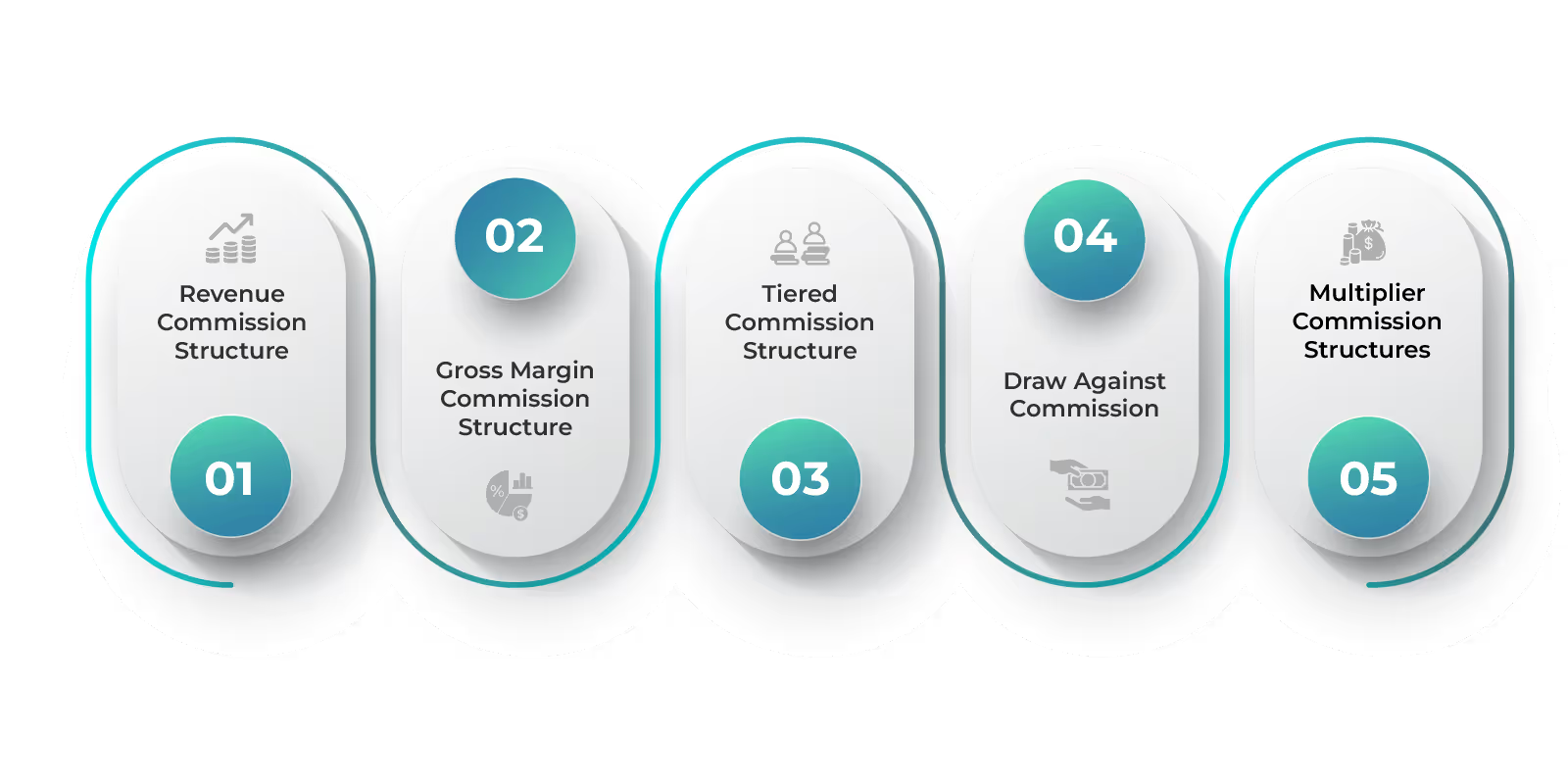
Blog
Straight Commission Plan: What are the Pros and Cons
March 15, 2024


Key Insights
Has company management still woken to the relevance of recognizing their salesforce?
In a recent study by Cooleaf, almost half of employees who participated said they'd leave a company that didn't praise or thank them for their work. This shows the importance of acknowledging your sales reps for their efforts, rewarding them for their achievements, and motivating them for consistent performance improvement.
Surely we cannot deny the direct link incentive rewards have on employee performance, engagement, and satisfaction. In the lack of such recognition, there are higher chances of employee dissatisfaction, quiet quitting, and higher attrition.
Straight commission plan is one such effective compensation structure that recognizes and rewards your salesforce for their performance, efforts, and strategies.
In this article, we will give you a comprehensive walk through straight commission, its advantages, disadvantages, and uses. In addition, we will also explore the various types of sales commissions and how to determine the best sales commission for your sales team.
Scroll down for more.
What are Straight Commission Plans?
Straight commission plans are incentive structures where the employee's salary is solely based on the sales they generate. There is no fixed or base salary under this compensation structure instead the employees earn a percentage of the revenue from the sales they made.
Straight commission compensation plan gives independence to sales reps to earn according to their potential and skill. Hence, it is a powerful motivational tool that boosts sales performance to enhance their earnings while driving revenue growth and organizational success.
Advantages of Straight Commission Plans
Building a straight commission plan for your salesforce offers a lot of advantages to your organization. Let's look at some of the benefits of straight commission sales:

Motivational Incentive
Straight commissions are a powerful motivational tool to boost sales performance and drive revenue growth. Since their earnings are directly linked to their hard work and strategies, salesforce will be motivated to incentivize their efforts to the best. The potential of high earnings will thus enhance the overall sales performance and productivity.
Cost-Effectiveness
From an organizational point of view, straight commissions are a cost-effective way of managing your salesforce pay. Here the salesforce are paid a percentage of the revenue they generate. Hence, compensation expenses align with sales performance and revenue generation making it a financially efficient option for organizations.
Flexible Compensation
Straight commission plans provide flexibility to both the organization and the salesforce. Sales reps can earn without a limit depending on their effort, potential, and hard work creating a sense of empowerment and confidence. Businesses can determine the commission percentage and incentive rates according to the changing sales targets, company objectives, and market conditions.
Alignment of Interests
Straight commission plan helps align the individual sales goals with the larger organizational objectives. In a straight commission compensation structure, sales reps are motivated to achieve their sales target and become eligible for their incentives. In addition, aligning these sales goals with the business objectives helps foster a sense of purpose where sales reps feel their efforts are an integral contribution to the business's growth and success.
Attracting New Talent
Straight commission plans attract top talents and a high-performing sales force to your organization. The potential of your limitless earnings and that being dependent on individual efforts and hard work will help organizations recruit skilled professionals who drive growth.
The possibilities of limitless earning and immense growth potential are what make a straight commission plan an attractive commission structure in sales management.
Disadvantages of Straight Commission Plans
While straight commission plans offer several benefits to both the employer and the employee, there are also a few drawbacks to be acknowledged. Let's look at what these setbacks of straight commission plans are:
Financial Uncertainty
Straight commission plans do not offer financial stability to salesforce. Since their income is linked to the closing of deals, there is pressure to ensure sales consistently. Market fluctuations can lead to inconsistent income and cause stress in sales reps with financial obligations. In addition, the straight commission also makes it hard for businesses to budget their incentive compensation plan.
Short-Term Focus
When sales reps work under a straight commission structure chances are that they might be focused on the short-term goal of closing deals as soon as possible. This can lead to sales processes that focus on faster conversion rates than building a meaningful and strong customer relationship. In the longer run, this fast-paced competitive business can also affect the brand image and customer satisfaction.
Potential for Ethical Concerns
A competitive sales commission structure like straight commission can hurt your sales process. It can so happen that sales reps take unethical sales tactics to fasten the sales journey. This includes exaggerating the benefits, misleading customers, or other unethical practices to win deals. This can even drag the company to legal issues and loss of customer trust.
High Attrition Chances
Straight commission structure can create an unhealthy environment where sales reps feel stressed and pressured to achieve their targets to earn income. With changing market trends and economic fluctuations, sales reps can face great financial instability. Hence there are chances that they will leave such a workspace to achieve a stable sales job with a fixed salary.
Lack of Team Collaboration
Straight commission pays for your individual performance and achievement. This can create a work environment where sales reps are hesitant to share knowledge, strategies, and best practices with their colleagues. It can hinder team coordination and collaboration which can negatively impact the overall sales operations and organizational growth.

While a straight commission plan has the potential to motivate sales reps with cost-effective operations, the work culture and environment it can lead to if unmonitored can negatively impact the sales management, business operations, and brand image.
Read more about Saas Commission here How to Tackle SaaS Sales Commissions: Designing a Winning Comp Plan?
When to Use Straight Commission Plans?
Straight commission plans can be an effective tool in businesses and industries where sales targets align with company objectives. So here are a few scenarios in straight commission examples that can be appropriately used:
- Straight commissions are used in sales-driven industries like real estate, insurance, automotive sales, and retail where employee earnings are directly linked to their sales achievements.
- Companies that focus on a performance-driven work culture opt for straight commission to motivate their employees to improve and excel.
- Straight commissions are effective during product launches and promotions to motivate sales reps to pursue sales opportunities for faster product adoption and revenue growth.
- Businesses with cyclical demand patterns make use of straight commissions where salesforce can capitalize on the increased sales volume to generate more income and during seasonal downturns, they are motivated to enhance their efforts for better sales.
- Startup ventures with limited resources and revenue choose a straight commission plan to align incentives with revenue generation. This motivates sales reps for accelerated market penetration, drives sales, and enhances overall business growth.
Sales compensation planning plays a pivotal role in shaping the structure of commission-based incentives, aligning them with the overarching goals of the organization and ensuring salesforce motivation and productivity remain high.
Wish to know how you go about accounting capitalized commission. Check out Key Steps and Best Practices for Capitalized Commissions under ASC 606.
Types of Sales Commission Structures
After understanding straight commissions, their advantages, disadvantages, and uses, let's look at some of the other common types of sales commission structures that help enhance your sales operations.

Revenue Commission Structure: In this commission structure, sales representatives earn a percentage of the revenue they generate from the sale. The commission percentage is usually fixed and their commission varies depending on the deal size.
Gross Margin Commission Structure: Under this structure, the commission percentage is calculated against the gross profit margin of the sales. Since the commission is calculated as a percentage of the profit share, sales reps will be motivated to focus on making higher-margin sales.
Tiered Commission Structure: Sales reps earn progressively higher commission rates as they exceed their targets. For example, a sales rep has a sales target of $10,000 for the quarter with a 5% commission percentage for each sale. They exceed this expectation and bring a deal of $15,000. The extra sale will be calculated at a higher commission percentage of 8%.
Draw Against Commission: During financial instability or a low sales period, sales reps can draw a fixed advance on their future commission. This amount will be deducted from future commission earnings thereby providing financial support during low-income periods.
Multiplier Commission Structures: With this structure, sales representatives earn commissions based on a predetermined multiplier applied to their sales performance. The multiplier can be adjusted based on various factors such as sales volume, product type, or customer segment, allowing for flexibility in commission calculations.

Depending on the business structure, resource availability, budget allocation, and various other operational factors, organizations choose either one or a combination of these commission structures to build an effective sales incentive program.
To read more about sales commission structures, check 9 Best Sales Commission Structures for Maximum Performance.
Determining the Best Sales Commission Structures for Your Team
Determining the best sales commission structure for your team begins with understanding what suits your operations best. This involves aligning your compensation with your business objectives, sales operations, organizational culture, etc.
Sales managers must study the industry norms, keep a close watch on the competitor standards, track their sales cycle, determine the sales roles, and choose key performance indicators to finally conclude which commission structure suits the best.
In addition, your business model, resource and budget availability, financial stability, and your team’s needs and preferences are decisive factors when choosing the ideal commission program.
The commission structure can be a combination of fixed salary and variable pay that provide financial stability and motivation to your salesforce. Or it can be a performance-driven commission like a straight commission plan that pays depending on your performance and revenue generation. Understanding the average sales commission rates by industry is essential for designing competitive compensation packages that attract top talent and drive performance.
Here is a tip: even incorporating few negative incentive examples like pay-cuts, demotion can improve the overall effectiveness of your commission plans.
There is no ideal commission structure. An incentive program becomes effective when the business makes the best use of it for its growth and improvement. Hence, your sales incentive can consist of a single commission structure or a combination of several commission programs.
Hence, building your incentive program is not a one-time process. It requires constant monitoring and review, trial and error to determine what suits you best. Followed by regular modification and updation to ensure it doesn't go obsolete.
In conclusion, the sales team must watch out for the industry trends and market conditions as well as look in for employee feedback and satisfaction while determining the best sales commission structure for your team.
To read more about sales commissions and know more about incentive automation, visit https://www.kennect.io/. For more information, Book A Demo NOW!
ReKennect : Stay ahead of the curve!
Subscribe to our bi-weekly newsletter packed with latest trends and insights on incentives.
Thank you! Your submission has been received!
Oops! Something went wrong while submitting the form.
Your data is in safe hands. Check out our Privacy policy for more info















